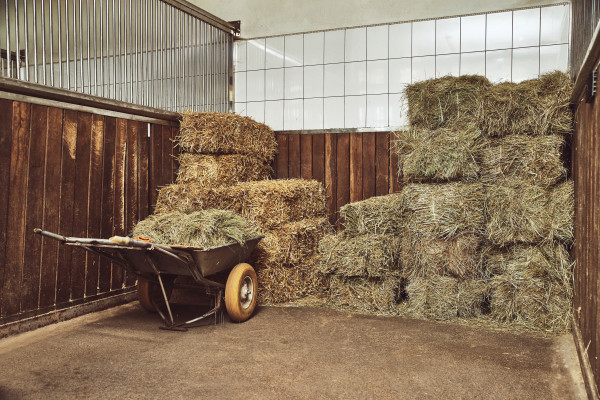The way you stock your hayloft or shed can save you money by preventing hay loss caused by mold and vermin. Quality hay left exposed to the elements and nesting animals rapidly becomes spoiled, unfeedable hay. Here’s how to be sure yours stays in peak condition during storage:

Make the roof watertight. Before you bring in new hay, check the floor for dark stains, indicating water leaks directly above them. If you stack hay in those spots, it will grow moldier with each rain. Have the leaky roofing material patched or replaced.
Catch condensation. If your loft or shed has a tendency to “sweat” as daily temperature changes cause interior condensation, tack a thin layer of plastic to the underside of the rafters to catch moisture that would otherwise fall on the bales.
Animal-proof the area. Plug rat and mouse holes with steel wool or rat-wire mesh. Welcome a resident blacksnake if one moves in because he’ll keep the rodent population in check better than any cat. But if you’ve seen evidence that larger wildlife, such as raccoons, move in during winter months, cover soft openings under the eaves with wire mesh, and keep windows and doors closed.
Click here to learn what dollar-store items can help you get your tack room organized
Leave the floor a little littered. Left on the mow floor, an inch or two of “fines,” consisting of hay leaves and other small particles, encourages air circulation beneath the bales, thus inhibiting mold growth. Stacking of hay on pallets is good for circulation, but the space beneath creates a perfect habitat for rodents.
Bring older bales up front. If you don’t make a point of rearranging all your leftover hay before each new shipment is added, you end up feeding newer hay first and leaving the old stuff to grow even more ancient and nutrient depleted. Pull old bales to the front or side before stacking in new hay, and feed them first before starting on the fresher supply.
Stack bales for circulation. Place bales on their sides so the more uneven, “nonstring” surface rests on the floor or underlying bales to encourage air circulation throughout the stack. Leave a bit of a space between the bales in each row, and alternate the orientation of successive layers so they sit at right angles with layers above and below. This pattern “ties” the stack together, while also keeping the bales from packing together too tightly.
Don’t miss out! With the free weekly EQUUS newsletter, you’ll get the latest horse health information delivered right to your in basket! If you’re not already receiving the EQUUS newsletter, click here to sign up. It’s *free*!








